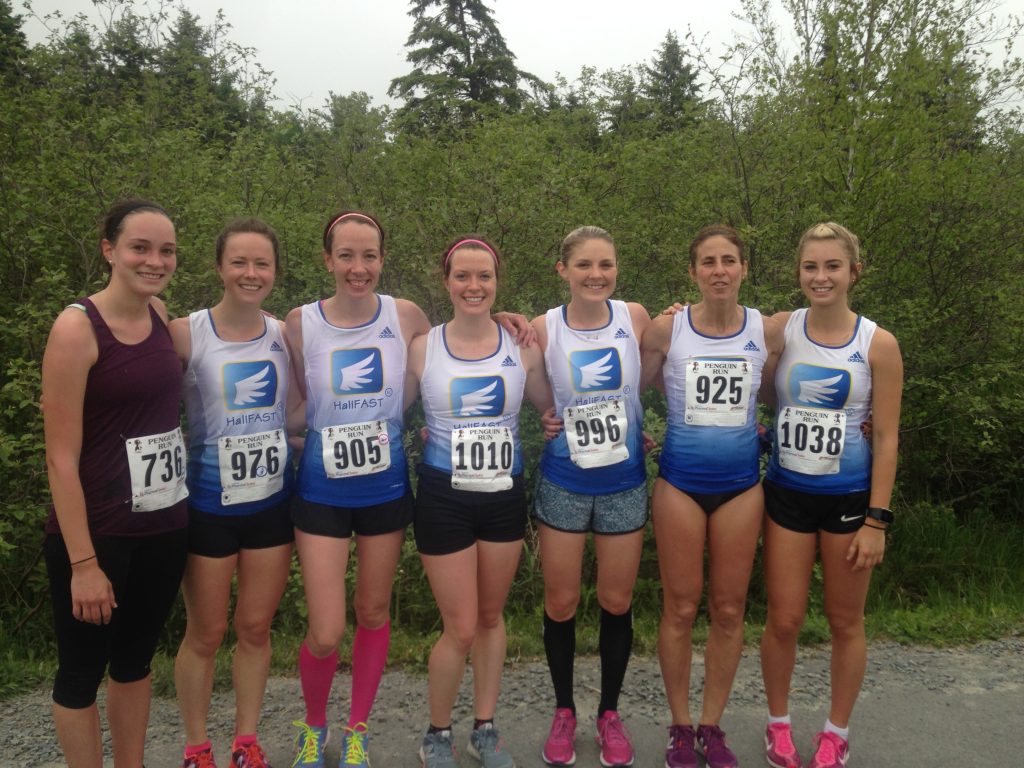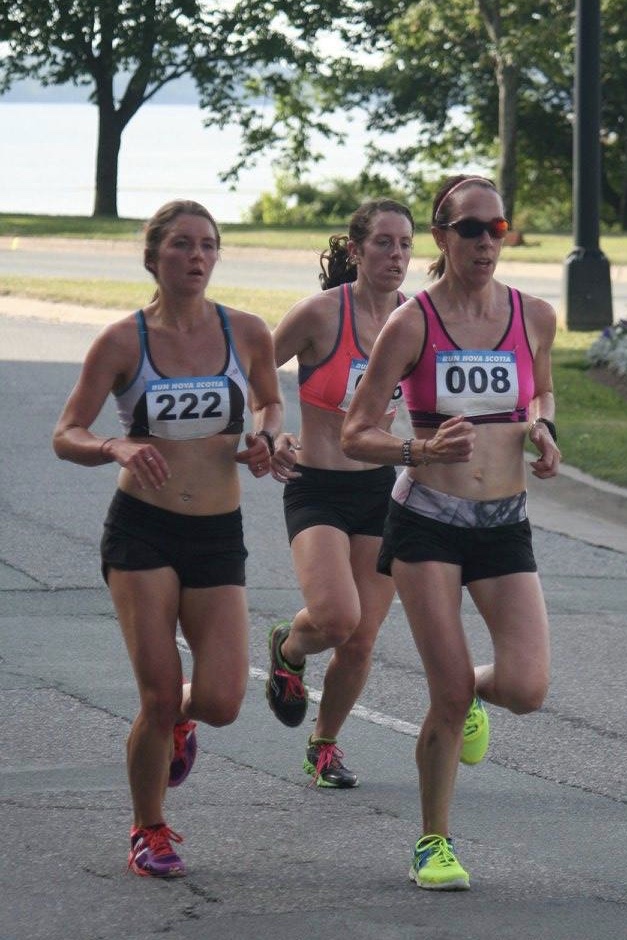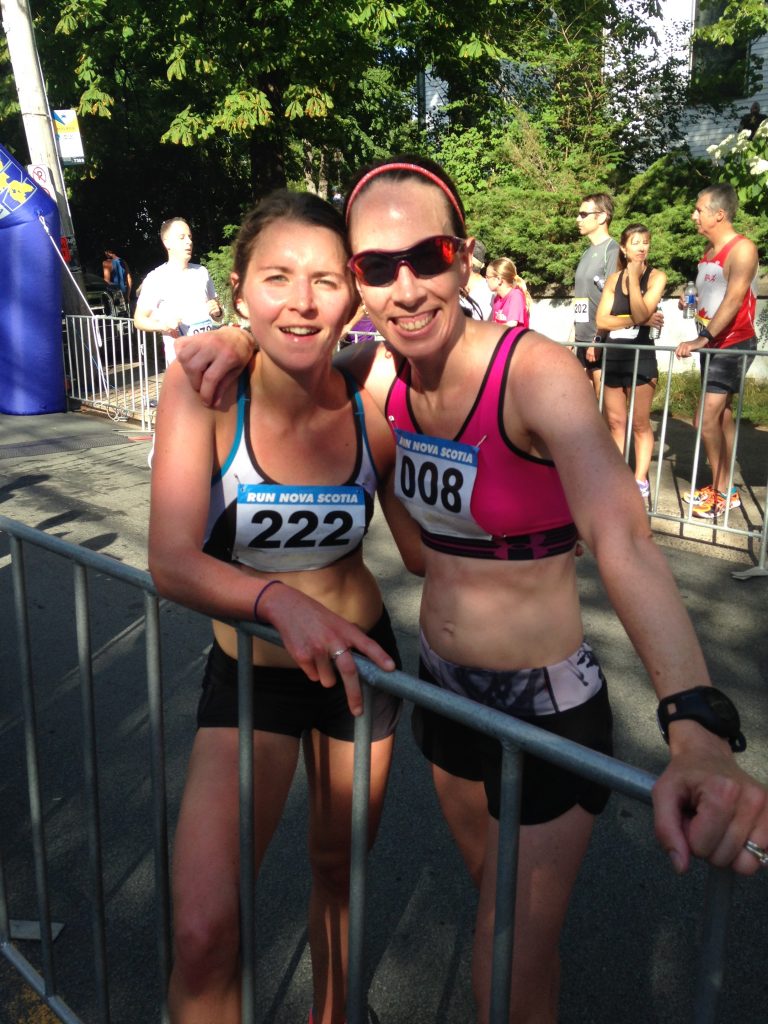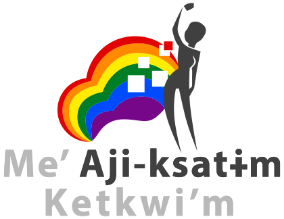Part One: July 27, 2016, pre-Natal-Day-Road-Race
The Training Partners
Natal Day Road Race is coming up and I am approaching this race with an uncharacteristic lack of enthusiasm. Part of this is related to having achieving a hard-fought for PB and feeling like, “check, been there, done that.” Part of this is the competition. It’s a competitive race. My performance counts because it’s on the Run Nova Scotia Performance Series. I don’t love racing head to head in a competitive race.
Then I was thinking about the Antigonish 5 miler. It was a competitive race. I went out as part of a group of 4 fast women. But these girls were my training partners. I didn’t feel like we were racing head to head. We were working together, each trying to help the other achieve their best race possible. There was no pressure re performance.
I like the idea of racing well when it counts; when the pressure is on. I’m working on it but I haven’t solved how to move forward from the wishy-washy feelings that I have towards this competitive race to embracing the desire to race well when it counts.
So I’ll think some more about running in my group of 4 women at Antigonish. In this pressure-free environment, we came in under the 8km race pace our coach had set for us in workouts. We finished in this order: Morgan, Maddie, Erin, Kayte. But the order never mattered to me. Though my opinion is only one of four women’s, this is what I know: we are simply better together. We didn’t really pull apart until 1km to go. The four  of us finished 16 seconds apart. We also rarely separate in training, in workouts. Because we are better together.
of us finished 16 seconds apart. We also rarely separate in training, in workouts. Because we are better together.

I’m always encouraging the runners that I coach to arrange their schedules so that they can do their workouts and long runs together. Because they are better together.
It’s summertime and both my husband and I are often reading several books at a time. Wind down and read together in bed is one of the best parts of the day. One my several books is usually a running book and right now, I’m reading “How Bad Do You Want It” by Matt Fitzgerald. There’s a chapter in here about what I’m talking about: runners being better together.
I believe that you are better together for several reasons:
- You are sharing the work together. Shared effort isn’t so hard even when the work is hard.
- You stay on for your partners. Even when you feel like quitting or letting up the pace, you don’t because the girl next to you might be relying on you to not quit.
- There are moments where you are strong when they are weak. And then other moments where they will be strong for you when you are weak
- You believe in your partners: in their ability and their guts. And if you are out there running next to them, that means that you have to believe in yourself too.
- You put the time in and the relationships get cemented. In a busy adult world, it can be challenging to find the time to put into relationships like friendships with people outside of your work life. But I know that I am going to see my training partners twice a week. My lunchtime run partner (same training group, different pace group at workouts) and I were talking about this some. His real life partner asked him to go to a social thing instead of post-workout beer one night and he was quick to agree because he already sees all of us 2-3 times a week. You have to keep the partner at home happy. But this is proof of training partner time together.
- You know each other and encouragement can be silent or involve very few words. In Antigonish, I called out a few splits and beyond that, the only thing that we said to each other over 31 minutes came from me at 1 mile to go as we were closing the gap on the girl in 3rd place (in a race with cash prizes): “Girls, she’s in the money spot, we gotta go.”
So that’s what I have to say about why we are better together. What does a published author say?
 How Bad Do You Want It is a cool book where each chapter covers a different part of “mental fitness” or “the psychobiological model of endurance performance” but begins with an account of a really awesome athletic experience by elite athletes. The chapter on “the Group Effect” “is an exciting play by play of the USA’s National XC Team at the 2013 IAAF World Cross Country Championships.
How Bad Do You Want It is a cool book where each chapter covers a different part of “mental fitness” or “the psychobiological model of endurance performance” but begins with an account of a really awesome athletic experience by elite athletes. The chapter on “the Group Effect” “is an exciting play by play of the USA’s National XC Team at the 2013 IAAF World Cross Country Championships.
Fitzgerald’s psychobiological model of endurance performance tells us that any factor that reduces the amount of effort an athlete perceives at a given level of exercise intensity will enhance performance. For Group Effect, the social dynamic that psychologists call behavioral synchrony shows us that when people work together, their brains release great amounts of mood-lifting, discomfort suppressing endorphins than they do when the same task is undertaken alone.
Behavioral synchrony elevates performance. Runners perceive less effort and perform better when training and racing cooperatively than they do alone. So, what I said: #bettertogether (maybe I should write a book, too). When the work is shared together, it’s isn’t so hard even when the work is hard.
So that is the effect at an individual group level. Group synchrony is important at a larger level too: when it creates a broader sport culture in which many groups of athletes train and race together often. Fitzgerald says that if the culture is vibrant, with many groups of motivated athletes training and racing together, behavioral synchrony achieves maximum intensity and effectiveness:
“A running culture sustains a social force that pushes all to a higher level than they might attain in a less cooperative environment” Fitzgerald.
That pretty much describes my vibrant training club.
The Coach
With a vibrant training club comes a coach. If you are lucky to have a running coach, especially an excellent one, you are better together with your coach too.
The coach/runner or coach/athlete relationship is a special one. Beyond my husband, my sister/most regular training partner (how lucky am I that my sister is my most regular training partner?) and my workplace, the person who I see the most and have the most communication with over the course of every week is my running coach.
I’m an online coach so I don’t get the face:face time with my own athletes. But my inbox collects more messages from my athletes each week than from my best friends and my other non-running-partner sister. Our relationship is over email and photos shared on social media. Anyone can pump out a training plan with some ideas and a calendar. You can find dozens for free online. To me, that’s not the special part of coaching. It’s the ongoing relationship and dialogue about how my runners’ bodies, lives and spirits are adapting to the training.
I’ve been blessed to run with three wonderful coaches: Matt Sheffield, Cliff Matthews and Lee McCarron. A few years ago (ok, many now), I wrote a piece about why running with a coach is so fantastic.
For this piece today, I’ve been thinking more about the how. How is it that you become better together? How is it that it becomes special? In my first coaching blog, I list four reasons why running with a coach is amazing but how do you get there?
The coach:athlete relationship is recognized as a contributor to athlete success. Do a google search and you can read a lot about the ingredients that should make up a successful coach:athlete relationship.
Before I get to what the experts say, here are a few of the ingredients that I think are important. Though first, I think that before you can see success in a coaching relationship, there are precursors to success that depend on the athlete’s relationship with their own self. You, the athlete, have to first believe in yourself. Once you get there, here’s what’s important with your coach:
- You care about each other.
- You believe and trust in each other. And the athlete trusts in the plan. I believe what they say: faith in the training plan is more important that the training plan itself.
- You share the same goals
- You are accountable to each other. You’re not in it alone and the athlete is willing to not be in it alone, meaning that they buy in and listen
- You can both keep perspective that things are important beyond the actual sport: real life, mind, spirit.
The world of coaching research likes a coaching model based on the “4Cs”. This coaching research (mostly by sports psychologist Sophia Jowett) tells us that a positive coaching relationship is based on four factors: closeness, complementarity, commitment, co-orientation.
So kind of what I just said. But here’s a breakdown nonetheless:
Closeness:
In coaching research speak, this is the emotional level of the relationship and relates to the perceived affective experience between coach and athlete.
In my words: do you like each other and do you want to spend time with each other?
Commitment:
In coaching speak, this is the cognitive aspect of the relationship and relates to the coach and athlete’s long term view about the relationship.
In my words: commitment can mean a lot of things. In my marriage/parenting, it means that we are in this both crazy and joyful chaos together and we are always on the same team. In brands, my husband is committed to Apple and Starbucks and only purchases these products. In coaching, you know that you are feeling commitment from your coach when you feel that you’re worthy of the attention offered. You believe it. The coach has the skill to convey to you that you matter. You have the confidence in yourself to believe it. You are committed to your coach when you buy into their style and their plan and you feel motivated to please them with your performance.
Complementarity:
In coaching speak, this is the behavioral aspect of the relationship and relates to the interaction between the coach and athlete.
In my words: do you respond well to the way that the athlete coaches you? Do you like their race plans and do want to execute them? Do you appreciate what they say to you in workouts? And from your end, are you enjoyable to work with?
Co-orientation:
This is the level of understanding and similarity between coach and athlete.
My words: Have you reached a common ground together? Are you friendly and easy to be with when you’re with them? Are they friendly and easy to be with back? Do they know what you need and do you know how to best be with them?
At the end of the training day, if you are lucky to find these ingredients with your coach like I have, you are going to run, race, perform #bettertogether.
Part Two: August 2, Post-Race
I reached out to a few people before Natal Day Race: my coach, my sister and my lunchtime run partner. I dropped the pressure to perform and chose to go out and race because I love to race and to enjoy working with my training partners.
My teammate Liz and I planned to go out and work together, stride for stride, for at least the first 2 x 2mile laps and as long as possible beyond that (6 mile race: 3 x 2mile laps).
Liz and I went out and had an amazing race day. Working together was awesome for the first 2 laps for all the reasons listed above. I had this day where I was totally on and into it. I set a huge 97 second PB with a 38:05 and Liz had a super impressive 6mile/10km debut at 38:21, proving this: #bettertogether.




2 Responses